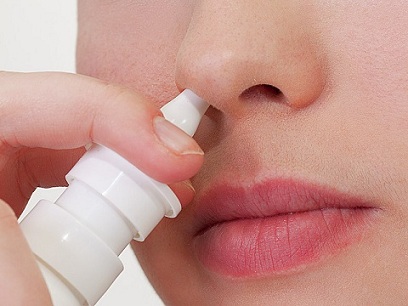Yet Another COVID-19 Prophylactic Intranasal Spray Debuting, This Time By University of Birmingham
Source: COVID-19 Intranasals Nov 20, 2020 5 years, 2 weeks, 4 days, 18 hours, 30 minutes ago
COVID-19 Intranasals: Scientists from the University of Birmingham have developed a nasal spray that can provide effective protection against the SARS-CoV-2 coronavirus by using materials already cleared for use in humans.

Airborne pathogens pose high risks in terms of both contraction and transmission within the respiratory pathways, in particular the nasal region. Although knowledge of airborne transmission has long been known, there is little in the way of adequate intervention that can protect the individual, or even prevent further spread. This study focuses on a nasal applicant with the capacity to combat such issues, by focusing on the SARS-CoV-2 virus.
The study team formulated a spray containing polysaccharides known for their mucoadhesive properties and characterized for their mechanical, spray patterns and antiviral properties. The ability to engineer key behaviours such as yielding has been shown, through systematic understanding of a composite mixture containing two polymers: Gellan and Lambda-carrageenan.
Use of such intranasals demonstrated highly potent antiviral capacities, resulting in complete inhibition of the virus when studied for both prophylaxis and prevention of spread.
Also, a mechanism has been proposed to explain such findings. Therefore, demonstrating the first fully preventative device, targeted to protect the lining of the upper respiratory pathways.
The study findings were published on a preprint server and are currently being peer reviewed.
https://www.biorxiv.org/content/10.1101/2020.11.18.388645v1
The proposed use of intranasals to combat COVID-19 is not new as many entities have been developing various intranasal prophylactics using a variety of agents including iodine (Although there are now claims that long-term of usage of iodine even at low concentrations is cytotoxic to human mucosal nasal tissues and can actually aggravate and accelerate COVID-19 infections), various steroids with antiviral properties ie budesonide etc.
In fact the use of carrageenan in intranasal formulations against COVID-19 was already proposed by researchers from Argentina and America since July.
https://www.thailandmedical.news/news/covid-19-research-american-led-study-shows-that-nasal-sprays-with-xylitol-and-iota-carrageenan-might-help-protect-against-covid-19
The study team from the university's Healthcare Technologies Institute formulated the spray using compounds already widely approved by regulatory bodies in the UK, Europe and the US. The materials are already widely used in medical devices, medicines and even food products.
Implications are that the normal complex procedures to take a new product to market are greatly simplified, so the spray could be commercially available very quickly.
The study describes cell culture experiments designed to test the ability of the solution to inhibit infection. The researchers found cell-virus cultures inhibited the infection up to 48 hours after bein
g treated with the solution and when diluted many times.
The intranasal spray is composed of two polysaccharide polymers. The first, an antiviral agent called carrageenan, is commonly used in foods as a thickening agent, while the second a solution called gellan, was selected for its ability to stick to cells inside the nose.
https://pdfs.semanticscholar.org/0841/7a6c4a4ab535bd089c7026255bf306483130.pdf
https://pubmed.ncbi.nlm.nih.gov/18817582/
https://europepmc.org/article/med/22643729
https://www.iraqidentaljournal.com/index.php/idj/article/view/17
Gellan is an important component because it has the ability to be sprayed into fine droplets inside the nasal cavity, where it can cover the surface evenly, and stay at the delivery site, rather than sliding downwards and out of the nose.
Dr Richard Moakes, lead author on the paper told media. "This spray is made from readily available products that are already being used in food products and medicines and we purposely built these conditions into our design process. It means that, with the right partners, we could start mass production within weeks."
The intranasal spray works in two primary ways. Firstly, it catches and coats the virus inside the nose, from where it can be eliminated via the usual routes either nose-blowing or swallowing. Secondly, because the virus is encapsulated in the spray's viscous coating, it is prevented from being uptaken by the body. That means it will reduce the viral load in the body, but also even if virus particles are passed on to another person via a sneeze or cough, that person is less likely to be infected by active virus particles.
Professor Liam Grover, co-author of the study said, "Although our noses filter thousands of liters of air each day, there is not much protection from infection, and most airborne viruses are transmitted via the nasal passage. The spray we have formulated delivers that protection but can also prevent the virus being passed from person to person."
The study team believes the spray could be particularly useful in areas where crowding is less avoidable, such as airplanes or classrooms. Regular application of the spray could significantly reduce disease transmission.
Dr Moakes added, "Products like these don't replace existing measures such as mask wearing and handwashing, which will continue to be vital to preventing the spread of the virus. What this spray will do, however, is add a second layer of protection to prevent and slow virus transmission."
Please help support this website by kindly making a donation to sustain this website and also all in all our initiatives to propel further research: https://www.thailandmedical.news/p/sponsorship
Thailand Medical News would like to warn all readers that despite the fact that certain COVID-19 intranasal sprays do have the capacity to reduce SARS-CoV-2 viral loads in the nasal cavities and airways, it is not a full proof method to prevent COVID-19 as studies are showing that the virus has other possible ways of entering the human host including via the eyes, ears and mouth and even possibly through other ways we are not mentioning just yet till studies emerge.
While using these intranasals, the use of other oral prophylactics coupled with wearing masks, social distancing, washing hands and extreme hygiene are strongly advocated.
Also read:
https://www.thailandmedical.news/news/covid-19-latest-study-shows-that-oral-infection-and-transmission-of-sars-cov-2-through-the-mouth-is-more-prevalent-than-thought
https://www.thailandmedical.news/news/covid-19-intranasal-drugs-novan-s-vitro-study-involving-berdazimer-sodium-demonstrates-antiviral-effect-against-sars-cov-2-in-human-airway
https://www.thailandmedical.news/news/university-of-connecticut-study-shows-intranasal-povidone-iodine-limits-covid-19-spread-and-acts-as-prophylaxis-for-medical-staff
https://www.thailandmedical.news/news/must-read-covid-19-treatments-researchers-now-focusing-on-nasal-spray-therapeutics-to-target-the-coronavirus-in-the-nose-to-prevent-covid-19
https://www.thailandmedical.news/news/covid-19-meds-austrian-vitro-study-finds-that-nasal-antihistamine-azelastine-could-be-repurposed-to-reduce-viral-transmission-or-as-a-prophylaxis
https://www.thailandmedical.news/news/breaking-covid-19-drugs-study-shows-that-fucoidan-extracted-from-seaweed-outperforms-remdesivir-in-inhibiting-sars-cov-2-in-cell-studies
https://www.thailandmedical.news/news/breaking-covid-19-drugs-study-trial-of-inhaled-corticosteroids-formoterol-budesonide-shows-potential-as-prophylactic-and-treatment-drugs
https://www.thailandmedical.news/news/covid-19-drugs-queensland-university-of-technology-and-oxford-university-exploring-budesonide-inhaler-therapy-for-early-covid-19-patients-in-new-trial
Please help support this website by kindly making a donation to sustain this website and also all in all our initiatives to propel further research: https://www.thailandmedical.news/p/sponsorship
For more on
COVID-19 Intranasals, keep on logging to Thailand Medical News.
